|
Short Communication
Primate research and conservation in northern Argentina: the field station Corrientes (Estación Biológica de Usos Múltiples — EBCo)
Gabriel E. Zunino1 and Martin M. Kowalewski1,2
1Estación Biológica de Usos Múltiples de Corrientes (EBCo), Museo Argentino de Ciencias Naturales, Argentina
2Dept. of Anthropology, University of Illinois, Urbana-Champaign, USA
Corresponding author email: [email protected]
Abstract
In Argentina two (Alouatta guariba and Aotus Azarai) out of five species of non-human primates are endangered (Alouatta caraya, Cebus nigritus, and Cebus paraguayanus). However, most of the forests these species inhabit are under continuous anthropogenic alteration and many are not protected. The Estación Biológica de Usos Múltiples de Corrientes (EBCo) is an academic and research institution established in 2001, and its main goals are to ensure the protection of plant and animal species living in the province of Corrientes, northern Argentina, and to develop environmental education in the area surrounding the station. We present a short review of the history of the EBCO, its goals, research, and conservation projects. The main research projects are related to the study of demography, ecology, and behavior of primates in northern Argentina and to the study of ecosystem health aimed at identifying risk factors for disease transmission. Conservation-oriented activities are aimed at improving the ability of conservationists and policy-makers regarding timber exploitation, wildlife conservation, and human health.
Key Words: Argentina, conservation, neotropical primates, Alouatta, Cebus, Aotus, EBCO
Resumen
En Argentina encontramos cinco especies de primates: Alouatta guariba and Aotus Azarai Alouatta caraya, Cebus nigritus, and Cebus paraguayanus. Dos especies se encuentran en peligro de extinción (A. guariba and A. azarai). La mayor parte de los bosques que estas especies habitan se encuentran bajo una continua alteración antropogénica y la mayoría de las poblaciones de primates viven en zonas de bosque no protegidas. La Estación Biológica de Usos Múltiples de Corrientes (EBCo) es una institución académica y de investigación establecida en 2001. Sus metas principales son la protección de la flora y fauna en la Provincia de Corrientes, al norte de Argentina, y el desarrollo de un plan de educación ambiental en el área que rodea la estación. Presentamos en este trabajo una revisión de la historia de la EBCo, de los objetivos, y de los proyectos de investigación. Estos ultimos están vinculados a estudios de demografía, comportamiento y ecología de primates. Otros versan sobre el estudio sobre el estado de salud de los ecosistemas y sobre la mejora de la capacidad de conservacionistas y políticos para tomar decisiones mas informadas acerca de la explotación de los bosques, la conservación de la fauna y flora, y el estado de salud de las poblaciones humanas en la zona.
Palabras clave: Argentina, conservación, primates neotropicales, Alouatta, Cebus, Aotus, EBCo
|
Received: 27 April, 2008, Accepted 12 May, 2008, Published: 9 June, 2008
Copyright: © 2008 Zunino, G.E. and Kowalewski, M.M. This is an open access paper. We use the Creative Commons Attribution 3.0 license http://creativecommons.org/licenses/by/3.0/us/ .The license permits any user to download, print out, extract, archive, and distribute the article, so long as appropriate credit is given to the authors and source of the work. The license ensures that the published article will be as widely available as possible and that your article can be included in any scientific archive. Open Access authors retain the copyrights of their papers. Open access is a property of individual works, not necessarily journals or publishers.
Cite this paper as: Zunino, G.E. and Kowalewski, M.M. 2008. Primate research and conservation in northern Argentina: the field station Corrientes (Estación Biológica de Usos Múltiples — EBCo). Tropical Conservation Science Vol.1 (2):140-150. Available online: tropicalconservationscience.org
Introduction
Distribution of primate species in Argentina
In Argentina there are five species of non-human primates: Alouatta caraya (black and gold howler monkeys), Alouatta guariba (brown howler monkeys), Aotus azarai (owl monkeys), Cebus nigritus (black capuchins), and Cebus paraguayanus (brown-capped capuchins) (Fig. 1). Alouatta caraya has the southernmost distribution of all the primates' species in the Neotropics, reaching latitude 29 °S (Province of Santa Fe). Both A. guariba and A. azarai are endangered species of primates in Argentina [1]. These five species inhabit three main types of forests in Argentina (Fig. 2 and 3) [2]: 1. The Pedemontana and Montana forests: Pedemontana includes remnant forests at the foot of theYungas mountains, and Montana includes cloud forests of the Tucuman, Catamarca, Salta, and Jujuy provinces; 2. The Paranaense forest (mainly in Misiones province); and 3. A complex of forests composed of: the humid Chaco forest, savannas, gallery forests, and flooded forests (Chaco, Formosa, Corrientes, and Santa Fe provinces). Each of these forests constitutes the habitat of one or more than one non-human primate species (Figs. 2 and 4, Table 1).
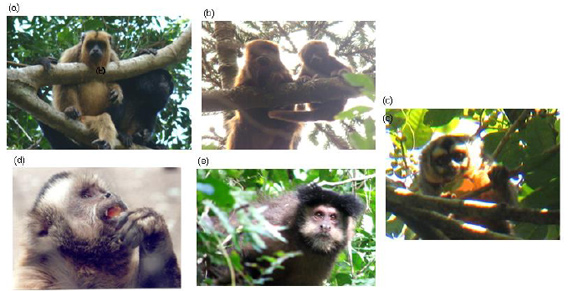
Fig. 1. Species of non-human primates found in Northern Argentina: (a) Alouatta caraya (black and gold howler monkeys), (b)) Alouatta guariba (brown howler monkeys), (c) Aotus Azarai (owl monkeys), (d) Cebus paraguayanus (brown-capped capuchins), (e) Cebus nigritus (black capuchins) (Pictures by Mariana Raño: a and b, DiegoBombelli: e, Romina Pave: d, Luciana Oklander: c)
The Pedemontana and Montana forests, of which 67% have already disappeared, are located in the NW portion of Argentina, and run from Bolivia, north to south, following the oriental cliffs of the mountains at an altitude ranging from 300 m to over 1,600 m. Precipitation is highly seasonal, with a concentration of almost 80% of rainfall during the summer. Precipitation also varies with altitude from 700 mm to over 3,000 mm. The only species that can be found in these forests is Cebus paraguayanus. The Paranaense forest (also known as Atlantic forest) covers most of the Misiones province. It constitutes a subtropical humid forest without rain seasonality which reaches almost 2,000 mm per year and an average temperature of 21o C. In this forest, we can find Cebus nigritus, Alouatta caraya, and Alouatta guariba. While Cebus nigritus can be found on most of this forest extension, A. caraya and A. guariba are restricted to forests within the province and to forests along rivers and streams. It is possible that A. guariba might be associated with forest of Araucaria angustifolia, and there are some forests in which both species of howlers are sympatric (Fig. 3). Only 7% of the original forest-cover from the Atlantic forest in South America remains in a highly fragmented landscape, and from this almost a 50% is found in northern Argentina [3].
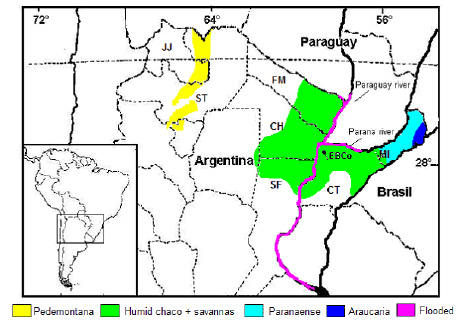
Fig. 2 . Vegetation types in northern Argentina with presence of primates.
In the flooded forest and in the humid Chaco forest east of the Parana river, the only species found is A. caraya. On the other hand, three species of primates (A. caraya, Aotus azarai, and C. paraguayanus) are found west from the Parana river. Specifically, Alouatta caraya is found to the west of the Parana river along riparian forests until the area where precipitation reaches 900 mm, and the range of A. azarai extends west until the area where precipitation reaches 1,000 mm. Finally, C. paraguayanus is rare in this area. Going south from this region, precipitation decreases and A. caraya is the only species found; most notably, A. caraya is the only non-human primate that inhabits the island system of the Parana River.
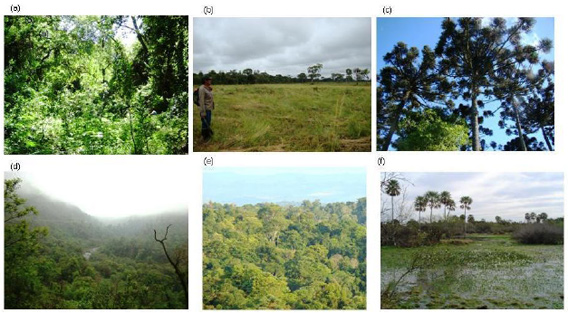
Fig. 3. Some examples of the types of forests from Northern Argentina: a) flooded forest (Chaco), b) Chaco forest and savannas (Corrientes), c) Paranaense forest, araucarias (Misiones), d) Pedemontana and Montana forests (Tucuman), e) Paranaense forest (Misiones), and f) esteros and palm forest (Corrientes). (Photos by Mariana Raño and Martin Kowalewski).
Deforestation trends and protected areas
Deforestation in northern Argentina increased between the years 2002 and 2006 almost 42% in comparison to the period 1998-2002 (preliminary data provided by the Secretaría de Ambiente y Desarrollo Sustentable, Argentina). The forests in Chaco and Misiones are in the worst condition. Livestock, soy and rice plantations, and forest exploitation have profoundly changed the composition of the forests and the herbaceous layer, eliminating the hardiest and most profitable forest tree species. Clearing out whole fragment forests for agriculture or establishing exotic fast-growing pastures is also contributing to a fast landscape change in the area. The forests of the Chaco have been commercially exploited since the late 1880s, and by the early 1990s it was estimated that only 10% of the original forested land remained [4].
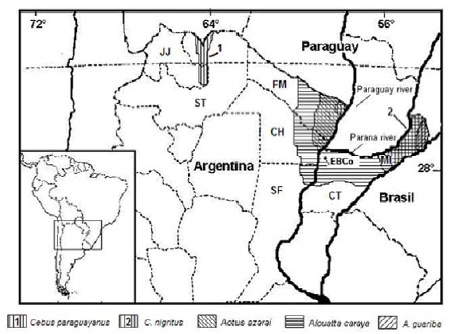
Fig. 4. Approximate distribution of primate species. Reference of provinces: Misiones (MI), Corrientes (CT), Santa Fe (SF), Chaco (CH), Formosa (FM), Salta (ST), and Jujuy (JJ)
In Argentina, there are protected areas such as national parks with wild primate populations (Table 1) and a limited number of state and private parks. However, national parks are not large enough to protect and support populations of larger and middle-sized mammals. For example, populations of C. nigritus and paraguayanus in protected areas are not larger than 5,000 individuals, populations of Alouatta caraya reach 10,000 individuals, and for Aotus azarai the number is smaller than 600 [2]. In all the ranges we can find primate species outside protected areas; however, they have to confront changes in forest structure due to land use (for example soy, rice, and forest plantations), and illegal hunting.
Table 1. Types of forest, primate species and national parks in northern Argentina. References: Alouatta caraya (AC), A. Guariba (AG), Aotus azarai (AA), Cebus nigritus (CN), C. paraguayanus (CP).
|
Types of forest |
Species |
Protected areas (km2) |
National Park |
|
Pedemontana |
CP |
1800 |
El Rey, Baritú, Calilegua |
|
|
AA, AC |
750 |
Chaco |
|
Humid Chaco |
AA, AC, CP |
600 |
Pilcomayo |
|
|
AC |
177 |
Mburucuyá |
|
Paranaense |
CN, AC, AG |
550 |
Iguazú |
|
|
|
|
|
Estación Biológica de Usos Múltiples (EBCo)
The EBCo is located in Northern Argentina near the city of de San Cayetano, in the northeast of Corrientes Province, Departamento Capital (27º 30' S, 58º 41' W). The EBCo is 20 km to the south of the city capital of the province, Corrientes (Fig. 5). The EBCo is an academic and research institution that has been working since 2001 and belongs to the Museo Argentino de Cs. Naturales (MACN - Argentine Museum of Natural Sciences). The EBCo works in cooperation with the Dirección de Recursos Naturales y Gestión Ambiental de la Provincia de Corrientes (Department of Natural Resources and Environmental Management of Corrientes Province).
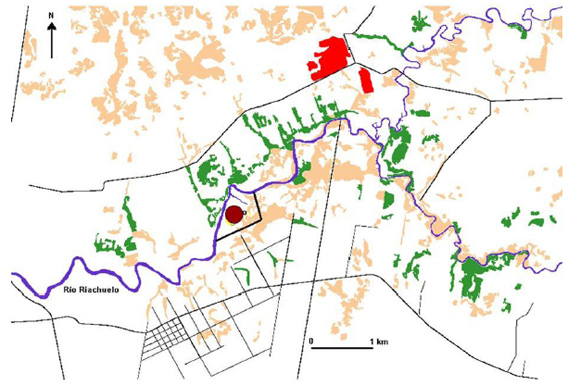
Fig. 5. Location of forest fragments around the EBCo (in green, tall forest; in pink low forest). Each tall forest fragment is associated at least with one group of black and gold howler monkeys. Red colored areas are plantations of Eucalyptus sp. and the grid at the bottom demarcates the city of San Cayetano. The maroon dot indicates location of EBCo.
The EBCo is located where the Centro Argentino de Primates (CAPrim) operated previously. The CAPrim was created in 1975 (formerly a research center of the Consejo Nacional de Investigaciones Científicas y Técnicas - CONICET) with the main goal of providing non-human primates for biomedical research to national and international institutions. For almost 20 years, the CAPrim led primatological research in Argentina. Pioneering field work on non-human primates in Argentina came from researchers associated with the CAPrim [for example 7-12]. In 1995, CONICET, following a restructuring, closed the CAPRim. In 2000, the Museo Argentino de Ciencias Naturales took over the infrastructure, with the main goal of creating a field station. In May 2001, CONICET approved the proposal and immediately we began to rebuild the station that had been abandoned for almost two years, after a flood in 1998.
Currently, the EBCO has five houses for researchers and visitors, one laboratory for basic research, a classroom, a library, a computer room, and a communal kitchen and dining room (Fig. 6). Such infrastructure allows the teaching of field courses and the development of short and long-term studies. EBCo has two appointed researchers, four graduate students developing Ph. D. dissertations, four undergraduate students, and five technicians.
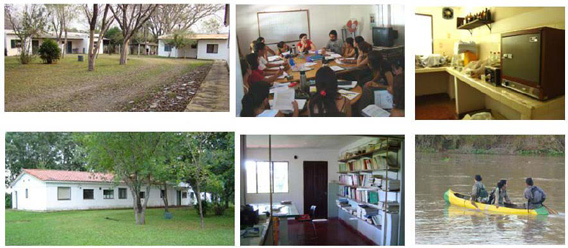
Fig. 6. Infrastructure of EBCo: Living quarters, meeting rooms, laboratories, library, and other views (Photos by Mariana Raño and Martin Kowalewski).
Research and conservation activities at EBCO
The EBCo is located in a rural area. The lands surrounding the EBCo are private. There are two kinds of private properties: small familiar properties (less than 10 ha) and large properties (up to 13,000 ha) that belong to private companies. In general most of the land available has increasingly been concentrated in the hands of such big landowners. During the last century the lands were used mainly for cattle ranching and cotton and tobacco crops. Today, lands are mainly used for cattle, and in the smaller properties, families develop subsistence agricultural gardens. Around the EBCo, there are no native indigenous communities as no indigenous people survived the Spanish conquest. Although most of the population is composed of descendants from European and indigenous people (mestizos), the low-income people still maintain the native language originally spoken in the area, the guarani, and a limited number of traditions.
The land in which the EBCo is found encompasses an area of almost 80 ha and in which the flora and fauna are permanently protected. The area is characterized by a savanna in an undulated landscape with sandy soils, both low and tall semideciduous forests, and aquatic environments. The high diversity of habitats correlates with a relatively high diversity of plant and animal species. For example, approximately 52 species of trees, vines, and shrubs have been identified at EBCo [10]. About 50 species of terrestrial mammals and 24 bats have been recorded. Some of these include Alouatta caraya (Atelidae), Mazama gouazoubira and M. Americana (Cervidae), Felis geoffroyi and F. yaguaroundi (Felidae), Hydrochaeris hydrochaeris (Hydrochaeridae), Myoscastor coypus (Myocastoridae), Lontra longicaudis (Mustelidae). At least 320 species of birds have been identified in the area (Contreras, personal communication).
The main goals of the EBCo are to ensure the protection of native habitats and of plant and animal species within its grounds and also in the rest of the province of Corrientes and to raise conservation awareness through environmental education in the area surrounding the field station. Another primary activity of the EBCo is to support the field research of both national and international researchers. In addition to this, the EBCo academic staff develops studies on the ecology, conservation, and sociobiology of non-human primates and their habitats in northern Argentina. One of these studies is a long-term project monitoring the demography of black and gold howler monkeys in Northern Argentina (Fig. 7) resulting in the accumulation of systematic information for primate populations in two different sites for the last 20 years [5, 6, 10,11,13-15].
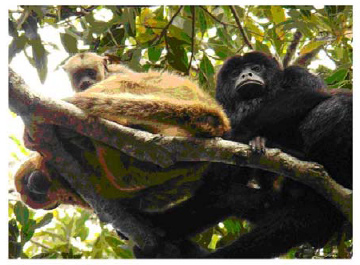
Fig. 7. Black and gold howler monkeys at the EBCo. The males are black and the females and infants golden. (Picture: Mariana Raño).
The forests surrounding the EBCo are selectively logged and clear cut, and the landscapes are characterized by isolated forest patches of 10-15 ha located in a matrix of grasslands. The average isolating distance between forest patches is 1,763.2 ± 538.7 m (N = 11 fragments) [16, 17]. Important tree species in these forest patches are Ficus. monckii (Moraceae), Eugenia uniflora (Mirtaceae), Melia azedarach (Meliaceae), and Gleditsia amorphoides (Fabaceae).
In the case of the primates, ecological density of black and gold howlers around the EBCO is reported to be close to one individual per hectare [5], whereas the ecological density of howlers on the island systems (flooded forest) is almost three individuals per hectare [6]. The island system runs along the Parana river 15 km west from the EBCo (Fig. 2). Primate research is carried out both in the area of the EBCO, where we have been monitoring 30-34 groups since 1984, and on the island system where we work mainly at the Isla Brasilera (27° 18' S, 58° 38' W). Here we have been monitoring almost 30 groups of black and gold howlers since 1997.
Implications for conservation
Overview of conservation issues
At the present we are developing three main research lines to accomplish the EBCo's goals: 1. formal and non formal educational programs; 2. long term research projects; and 3. support of national and international students from the Americas (Fig. 8).
Education
Since 2001, field courses on primate behavior, ecology, and conservation have been taught yearly with the goal of providing detailed information of current methodologies, research (primate ecology and behavior), and conservation problems. In 2004, we added an annual theoretical course with the goal of instructing students on current theoretical advances in primatology.
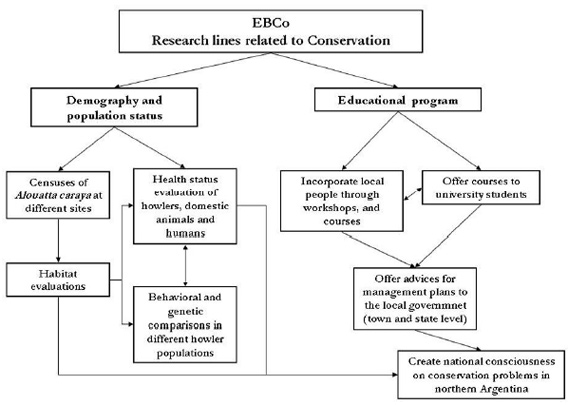
Fig. 8. Flow diagram showing the conceptual framework of conservation research carried out at the EBCo.
Originally designed for Argentinean students, the field courses have attracted the interest of students from other countries (Figs. 9 and 10). When the first course was organized and offered by EBCo in 2001, only nine students attended. Since 2003, all courses have operated at full capacity (20 students), and since 2005 we have offered two similar courses to better incorporate all interested students. We believe that the growing interest in the EBCo courses is due to the lack of comparable primatology courses in South America.
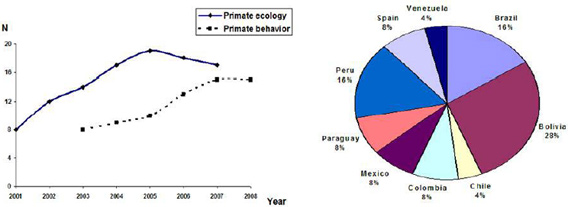
Fig. 9. Total number of students in each course of Primatology taught at the EBCo. For the period 2001-2007 the Field Techniques course; for the period 2003-2008 the Social Behavior course. Fig. 10. Proportion of foreign students (14.3% of the total, N=25) by country of origin in courses taught at the EBCo. In total 150 Argentinean students assisted to the courses.
Since its foundation, courses offered at the EBCo on primatology and conservation biology have had one goal: keep the cost of participation affordable for students from developing countries. Field courses are taught during July-August and the theoretical course is taught in March. The material and topics covered are equivalent to an upper division university-level course in the study of primate social behavior and general principles of animal behavior and forest conservation. Concepts and theories are discussed in seminar-like classes and are illustrated through direct observations and field experimentation. Working closely with the faculty, each student designs his/her own project and conducts independent research in the field. Evaluations consist of a paper presentation, the defense of a research proposal, the presentation of results, and the writing of a short professional report. Each course has a very low fee, and this includes study materials, food, lodging, and full use of the field station.
Major topics covered in the course are: introduction to primate behavior and ecology, primate taxonomy and adaptations, monkeys as members of forest communities, feeding ecology and foraging strategies, social organization and primate dispersal patterns, life history traits and population dynamics, sexual selection and kin selection (sociobiology), parental care and socialization of the young, conflict and cooperation, aggression and dominance, primate cognitive skills, human impact on primate populations, and conservation strategies for the protection of primate species. For additional information regarding the field courses offered at EBCo please visit https://netfiles.uiuc.edu/mkowalew/www/SAPRIM/
Raising conservation awareness among local inhabitants
In 2007 we began to develop a non-formal education program in the local elementary and high schools. This program involves regular visits to the schools to give talks, and the students and teachers come to the EBCo to attend workshops and educational activities in the native forests. The main goal of this educational program is to incorporate local people in the EBCo's conservation activities (Fig. 11). This involves orientation on how to protect and conserve native forests and to use them in a sustainable manner. Such an approach also involves interactions between EBCo's researchers and teachers, authorities, and people from the local community.
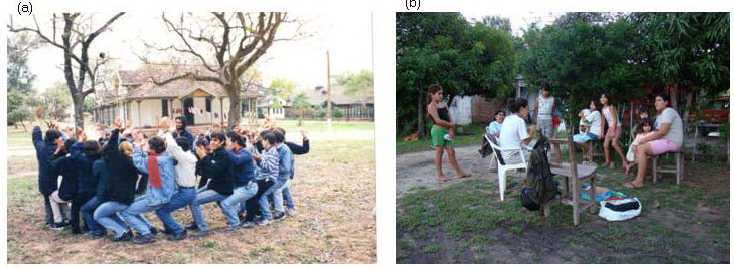
Fig 11. (a) Researchers coordinating environmental education activities with local high school students, (b) interviewing people around the EBCo (part of habitat health status project) (Photos by Mariana Raño and Martin Kowalewski)
Research projects
Long-term studies deal with behavior, ecology, habitat fragmentation, health status, and demography in black and gold howler monkeys. These cover populations living in different habitats ranging from flooded to subtropical forests. Some studies have revealed that black and gold howlers have characteristics that are particular to the area (near to the southern limit of distribution). For example, in the gallery forest (EBCo) there was evidence of a birth peak during the most food-limited time of the year. In the flooded forest study site (27 km north from EBCo), however, births occurred throughout the year. These results support the contention that howler monkeys do not have a fixed birth season, and that the observed variation in the timing of births appears to represent a facultative behavioral response to changes in food availability [see 5]. On the other hand, comparative studies of the population from 1982 to 2004 suggest that howlers can cope relatively well with moderate deforestation and fragmentation of the forest [5, 15]. However, recent studies indicate an incipient process of isolation for the population of howlers living in an area of 5,000 ha surrounding the EBCo [17]. Based on genetic data, Oklander [16] suggests that habitat fragmentation may serve to decrease the ability of howlers to disperse between groups. Isolation can lead to inbreeding depression unless gene flow is restored by developing of biological corridors in the area of the EBCo.
Another set of research projects focuses on ecosystem health, disease transmission, and habitat disturbance. This research addresses questions concerning the relationship between the dynamics of zoonotic disease transmission and the health status of non-human primates, humans, and domestic animals inhabiting a rural environment in northern Argentina. Local human populations, cattle, and other domestic animal populations, together with several groups of black and gold howler monkeys, are being studied in regard to levels of infection, prevalence, and richness of gastrointestinal parasites at different sites. These sites vary in their degree of habitat alteration, degradation, and levels of contact with humans.
Other initiatives
The EBCo actively collaborates with universities of Argentina such as the Universidad de Buenos Aires (UBA) and Universidad Nacional del Nordeste (UNNE). The universities bring students to develop studies and to participate in field courses. We are also collaborating with researchers of the UNNE and NGOs. From its creation, a total of 10 students have developed undergraduate theses and two students have developed Ph. D. dissertations theses at EBCo [16, 18].
In summary, the presence and operational and logistical support provided by the EBCo has been instrumental in developing and sustaining research on primate behavior and ecology, forest ecology, ornithology, entomology, herpetology, inventorying biodiversity, ethnobotany, and art and photography.
Acknowledgements
We thank Ramon Romero, Miguel de los Santos Blanco, Matildo Martinez, Angel Ramon Martinez, Teodoro Martinez, Luciana Oklander, and Silvana Peker for assisting in the development of the field station. We are also grateful to all the students who work at the field station and attend our courses. We also are grateful for the support provided by The National Council of Scientific and Technological Research of Argentina (CONICET - Consejo Nacional de Investigaciones Científicas y Técnicas) and the Argentinean Museum of Natural Sciences (MACN - Museo Argentino de Ciencias Naturales). For news about Argentina's primatology (in Spanish), please visit the EBCo's blog (http://ebco.blogspot.com/) and/or the webpage of the Sociedad Argentina de Primatología https://netfiles.uiuc.edu/mkowalew/www/SAPRIM/). We thank Alejandro Estrada, Melissa Raguet and two anonymous reviewers for valuable comments on earlier versions of this manuscript.
References
[1] G.B. Diaz y R.A. Ojeda 2000. Libro Rojo de Mamíferos Amenazados de la Argentina. SAREM.
[2] Brown, A. D., and Zunino, G. E. 1994. Habitat, densidad y problemas de conservación de los primates de Argentina. Vida Silvestre Neotropical. (3(1)):30-40.
[3] Pacha, M. J. and Guerrero-Borgues, V. 2006 Conservation of the Upper Parana Atlantic forest: integration at different scales. Workshop on Forest Fragmentation in South America — San Carlos de Bariloche.
[4] Anonymous. 2003. Atlas de los Bosques Nativos Argentinos. Secretaría de Ambiente y Desarrollo Sustentable. Dirección de Bosques. Proyecto Bosques Nativos y Areas Protegidas. BIRF4085. Buenos Aires, 243 p.
[5] Zunino, G. E., Kowalewski M. M., Oklander L. I., and Gonzalez V. 2007. Habitat fragmentation and population size of the black and gold howler monkey (Alouatta caraya) in a semideciduous forest in northern Argentina. American Journal of Primatology. 69:966—975.
[6] Kowalewski, M. M., and Zunino, G. E. 2004. Birth Seasonality in Alouatta caraya in Northern Argentina. International Journal of Primatology. 25(2):383-400.
[7] Colillas, O., and Coppo, J. A. 1979 Breeding Alouatta caraya in Centro Argentino de Primates. In: Recent advances in primatology, D. J. Chivers and W. Lane-Petter (Editors), Vol. 2, pp. 201-214, Academic Press, NY.
[8] Coppo, J. A. 1978 Hematological values in howler monkeys (Alouatta caraya) and its physiological variations. Acta Bioquímica Clínica Latinoamericana. 12:97-115.
[9] Thorington, R. W. Jr., Ruiz, J. C., and Eisenberg, J. F. 1984. A study of a black howling monkey (Alouatta caraya) population in northern Argentina. American Journal of Primatology. 6(4):357-366.
[10] Rumiz, D. I., Zunino, G. E., Obregozo, M. L., and Ruiz, J. C. 1986. Alouatta caraya: Habitat and resource utilization in northern Argentina. In: Current Perspectives in Primate Social Dynamics, Taub D. M. and King F. A. (eds.), pp. 175-193,Van Nostrand Rehinold, NY.
[11] Rumiz, D. I. (1990). Alouatta caraya: Population Density and Demography in Northern Argentina. American Journal of Primatology. 21: 279-294.
[12] Zunino, G. E. 1989. Hábitat, dieta y actividad del mono aullador negro (Alouatta caraya) en el noreste de la Argentina. Boletín Primatológico Latinoamericano. 1(1):74-97.
[13] Zunino, G. E. 1996. Análisis nacimientos en Alouatta caraya (Primates, Cebidae) en el noreste de la Argentina. Revista Museo Argentino de Ciencias Naturales, Nueva Serie. 133:1-10.
[14] Zunino, G. E., Gonzalez, V., Kowalewski, M. M., Bravo, S. P. 2001. Alouatta caraya, relations among habitat, density and social organization. Primate Report. 61:37-46.
[15] Kowalewski, M. M., and Zunino, G. E. 1999. Impact of deforestation on a population of Alouatta caraya in northern Argentina. Folia Primatologica. 70:163-166.
[16] Oklander, L. I. 2007. Estructura social y relaciones de parentesco en poblaciones silvestres de monos aulladores (Alouatta caraya) del noreste argentino. Ph. D. thesis, Universidad de Buenos Aires, Argentina.
[17] Oklander, L. I., Zunino, G. E., Di Fiore, A., and Corach, D. 2007. Isolation, characterization and evaluation of 11 autosomal STRs suitable for population studies in black and gold howler monkeys Alouatta caraya. Molecular Ecology Notes. 7:117—120.
[18] Kowalewski, M. M. 2007. Patterns of affiliation and co-operation in howler monkeys: an alternative model to explain social organization in non-human primates. Ph. D. thesis, Dept. of Anthropology, University of Illinois at Urbana-Champaign.
|












